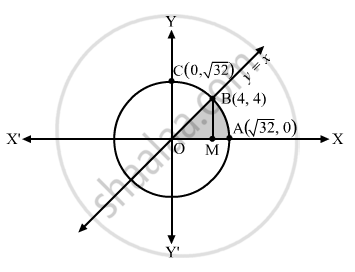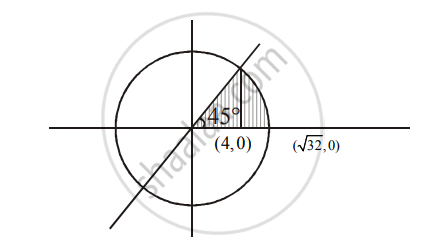Advertisements
Advertisements
प्रश्न
Find the area of the region in the first quadrant enclosed by the x-axis, the line y = x and the circle x2 + y2 = 32.
Using integration, find the area of the region in the first quadrant enclosed by the x-axis, the line y = x and the circle x2 + y2 = 32.
उत्तर १
y = x ...(1)
x2 + y2 = 32 ...(2)
The region enclosed by y = x and x2 + y2 = 32 is shown in the following figure:

On solving (1) and (2) we find that the given line and circle meet at B(4, 4) in the first quadrant. Let us draw BM perpendicular to the x-axis.
Now, required area = area of triangle BOM + area of region BMAB
Area of triangle BOM `=int_0^4ydx=int_0^4xdx=1/2[x^2/2]_0^4=8.........(3)`
Area of region BMAB= `int_0^sqrt32ydx=int_0^sqrt32sqrt(32-x^2)`
`=[1/2xxsqrt(32-x^2)+1/2xx32xxsin^(-1)(x/sqrt32)]_4^sqrt32`
`=(1/2 xx sqrt32 xx 0+1/2xx 32 xx sin^(−1)(1))−(1/2 xx 4xx 4+1/2 xx 32 xx sin^ (−1)(1/sqrt2))`
`=8π−8−4π`
∴ Area of triangle BOM=4π−8 ... (4)
On adding (3) and (4), we have:
Required area =`8+4π−8=4π`
उत्तर २
Put y = x in `x^2 + y^2 = 32`
`:. x^2 + x^2 = 32`
`2x^2 = 32`
`x^2 = 16`
x = 4
`A = int_0^4 y_"line" dx + int_4^(sqrt32) y_"circle" dx`
`A = int_0^4 xdx + int_4^(sqrt32) (sqrt(32-x^2))dx`
`= (x^2/2)_0^4 + int_4^(sqrt32) sqrt((sqrt32)^2 - x^2 )dx`
`= (8) + (x/2 sqrt(32-x^2) + 32/2 sin^(-1) (x/sqrt32))^(sqrt32)`
`= (8) + (0 + 16 xx pi/2 - (2sqrt16 + 16sin^(-1) (4/sqrt32)))`
`= 8 + 8pi - 8 - 16 sin^(-1) (1/sqrt2)`
`= 8pi - 16 xx pi/4 = 8pi - 4pi = 4pi sq unit`

APPEARS IN
संबंधित प्रश्न
Using integration find the area of the triangle formed by positive x-axis and tangent and normal of the circle
`x^2+y^2=4 at (1, sqrt3)`
Find the area of the region bounded by the curve y2 = 4x and the line x = 3
Area of the region bounded by the curve y2 = 4x, y-axis and the line y = 3 is ______.
Find the area of the smaller region bounded by the ellipse `x^2/a^2 + y^2/b^2 = 1` and the line `x/a + y/b = 1`
Find the area of the region {(x, y) : y2 ≤ 4x, 4x2 + 4y2 ≤ 9}
Using the method of integration, find the area of the triangle ABC, coordinates of whose vertices are A (4 , 1), B (6, 6) and C (8, 4).
Find the equation of an ellipse whose latus rectum is 8 and eccentricity is `1/3`
Find the area of the smaller region bounded by the ellipse \[\frac{x^2}{9} + \frac{y^2}{4} = 1\] and the line \[\frac{x}{3} + \frac{y}{2} = 1 .\]
Find the area of the region bounded by the following curve, the X-axis and the given line:
y = 2 – x2, x = –1, x = 1
Fill in the blank :
Area of the region bounded by y = x4, x = 1, x = 5 and the X-axis is _______.
Solve the following :
Find the area of the region bounded by the curve xy = c2, the X-axis, and the lines x = c, x = 2c.
Choose the correct alternative:
Using the definite integration area of the circle x2 + y2 = 16 is ______
The area of the shaded region bounded by two curves y = f(x), and y = g(x) and X-axis is `int_"a"^"b" "f"(x) "d"x + int_"a"^"b" "g"(x) "d"x`
The area of the circle x2 + y2 = 16 is ______
Find the area of the region bounded by the parabola y2 = 25x and the line x = 5
Find the area of the region bounded by the curve y = `sqrt(2x + 3)`, the X axis and the lines x = 0 and x = 2
Find the area of the region bounded by the curve y = (x2 + 2)2, the X-axis and the lines x = 1 and x = 3
Find area of the region bounded by the parabola x2 = 4y, the Y-axis lying in the first quadrant and the lines y = 3
Find the area of the region bounded by the curve x = `sqrt(25 - y^2)`, the Y-axis lying in the first quadrant and the lines y = 0 and y = 5
`int_0^log5 (e^xsqrt(e^x - 1))/(e^x + 3)` dx = ______
`int "e"^x ((sqrt(1 - x^2) * sin^-1 x + 1)/sqrt(1 - x^2))`dx = ________.
The area bounded by the X-axis, the curve y = f(x) and the lines x = 1, x = b is equal to `sqrt("b"^2 + 1) - sqrt(2)` for all b > 1, then f(x) is ______.
The area (in sq.units) of the part of the circle x2 + y2 = 36, which is outside the parabola y2 = 9x, is ______.
The area (in sq. units) of the region {(x, y) : y2 ≥ 2x and x2 + y2 ≤ 4x, x ≥ 0, y ≥ 0} is ______.
Find the area of the regions bounded by the line y = −2x, the X-axis and the lines x = −1 and x = 2.
